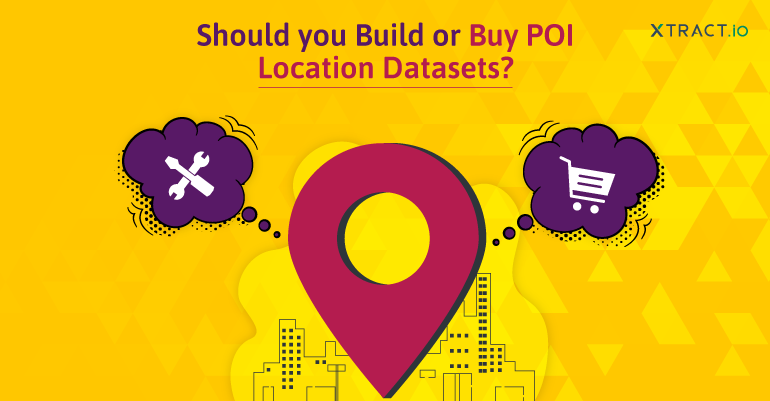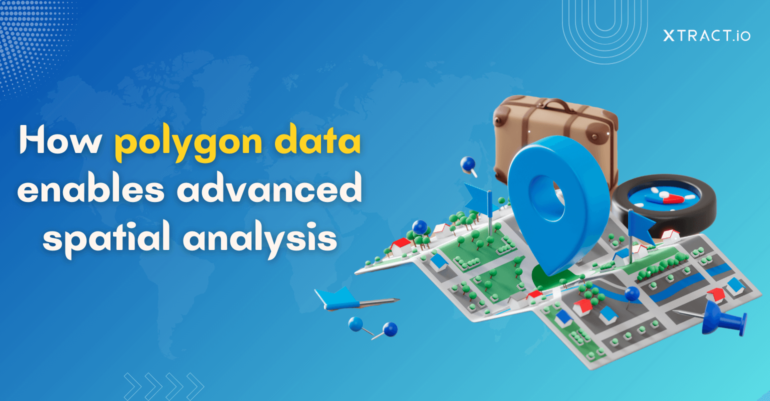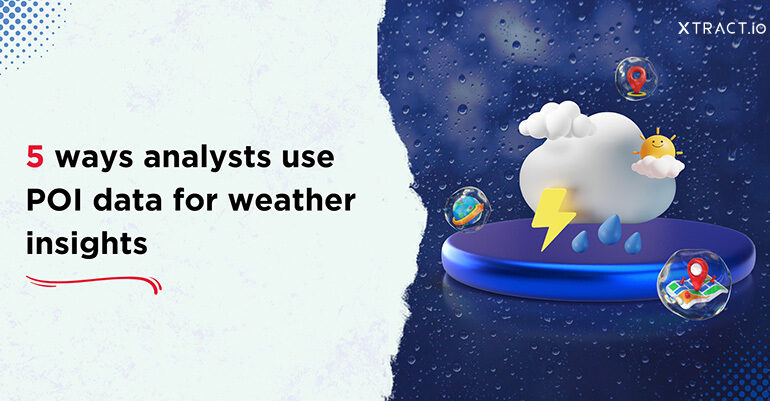Data is an integral part of any business to make informed decisions. According to Forbes, 59% of businesses use data to boost their performance, sales, and operations. POI Location datasets are one of the data types that have changed the business landscape in many ways by providing accurate insights for organizations to make better decisions. A few include choosing the right site for a new store or business, executing location-based targetted marketing campaigns, enhancing the city’s infrastructure with public insights, understanding your true competitors, their actions and strategy, and many more.
Location datasets can either be built in-house by the company or purchased from a POI data vendor, like Xtract.io. In both ways, there are multiple factors to consider in this decision. First, identify the business objectives that seek location insights, followed by the available budget to decide if your company can build vs. buy POI datasets. This blog will walk you through various factors that will help you to make an informed decision.
Do you need location datasets?
Before we begin to understand how you want the location datasets to be available to you, let us first analyze if you really need location data and, if you do, how does it impact your business.
The market size of global location analytics is estimated to reach $31.13 billion by 2027, compared to a $10.29 million valuation in 2019. This clearly indicates that the need for location data is ever-increasing, and businesses must leverage location data to make informed business decisions based on real-time geospatial data and information. Here’s an overview of prominent industries and how they use location data in their operations.
- Retail – Select sites to build brick-and-mortar shops/stores based on the population density in the specific location
- Ecommerce – Enhance customer experience by delivering the goods at the right time and place
- Healthcare – Measure health check accessibility in a locality and determine its impact on people’s health
- Banking and Finance – Assess brands and industries that will have good returns in the future and analyze ATM positioning in the city
- Government – Improve the city’s infrastructure and build smarter cities by analyzing the locations.
- Telecom – Plan network set-up based on demand and competition in a location
- Marketing – Execute targetted marketing campaigns based on the demographics of the location and target audience
- Real estate – Choose profitable properties for investments that would yield better results when sold to buyers
- Restaurant – Determine the foot traffic of a particular restaurant to identify the tastebuds of most people visiting that location
Building POI location datasets
“Building” your dataset means setting up an in-house system to extract and process the POI data with the help of equipped infrastructure, data scientists, and GIS analysts. You don’t have to purchase from an external vendor or hire a third party to build a dataset for you. While considering this type, factors such as operating cost, ensuring quality, refreshing, and maintaining the database regularly is very important. Let’s explore the factors in detail to note while building location datasets.
- Cost: Building location datasets involves a lot of costs, and businesses must ensure that they have a minimal budget to create quality datasets.
- First, recruitment cost, which involves getting qualified resources onboard, such as GIS experts, AI/ML experts, and software engineers, to build datasets.
- Second, building web scraping tools to scrape POI information from the public is an additional cost to the company.
- Third, infrastructure costs, i.e., server, database, and storage costs.
Other additional costs include partnerships, data maintenance, resource to manage data anomalies, and many more.
- Data Quality – This factor is vital to your brand image because poor quality data can affect your business reputation and significantly impact the cost.
To begin with, you can start by using POIs available online for free, such as from OpenStreetMaps. These data sources usually offer continual user-generated places. However, do note that the coverage of these sources may be limited. Only 7 out of 10 places can be extracted. Therefore, a web scraping tool must be built and automate bots to create custom POIs. While building POI datasets on your own, you should also ensure that the place exists in real-time. If not, this can cause serious problems in data analysis and modeling.
- Data Maintenance – Data cleansing, refreshing, and maintaining are one of the most time-consuming tasks. However, it is important because shops or stores close, open, vacate, and shift from one place to another at any given moment. The Covid-19 pandemic is one latest example that forced businesses to shut down their outlets. In such cases, updating this information in the POI database is essential.
Additionally, attributes of a few POIs may change, such as opening and closing hours, shop numbers, facilities, etc. Therefore, these must be updated before using them for location-based analysis.
- Scalable platforms – POI data requirements are huge and unique. Almost every industry is looking for location-based data and insights to boost their business performance. Therefore, in addition to data scientists and engineers who develop these datasets, you also need a research team that can show you the POI needs of the future. When you build POI datasets in-house, future requirements need to be anticipated. Therefore, a scalable platform is important to cater to new geographies, industries, or attributes for future POIs.
Buying POI location datasets
You can buy location datasets in two ways – partially, by collecting the raw data of POIs and processing it internally or fully, i.e., purchasing from a POI vendor, like Xtract.io – that manually creates polygons of POIs to ensure 100% accuracy. Before you choose a POI vendor, check if they meet these 5 criteria.
- Cost – All the overhead cost of recruiting skilled resources and building platforms, tools, and infrastructure gets canceled while opting for this method. It is noted that the cost of creating a POI dataset in-house is usually slightly more expensive than buying from the vendor. Therefore, validate if the amount, time, and effort spent in creating POI datasets are justified compared to buying, where the risk of failure is minimal.
- Data licensing – Double-check the licensing terms while you leverage a POI data vendor. In rare scenarios, POI vendors do not allow buyers to use their POI data for commercial uses. Also, before licensing, it may be mandatory to ask the following questions –
- How many industries or geographies have been covered?
- What are their quality and coverage percentage?
- What is the total volume of the records?
- Flexible platforms – When you buy POI data from the vendor, ensure that they offer all flexible delivery formats that can help you ingest the data to your platforms. POI data can be delivered through various ways – excel files, data visualization models, or directly integrated into the company’s API. Also, ensure that on-demand data generation is possible and delivered on time. Xtract.io is a POI and Polygon data vendor that ensures 95% accuracy and 96% global coverage. They also help customers by fulfilling on-demand POI data requirements.
- Authenticity & Refresh Cadence – Check the actual source of the data that the POI data vendor is providing you. The data licensed must be from reliable sources and not contain any faulty locations. Similarly, ensure that POI data is updated regularly to attain recency.
- What is the source of data?
- How often is the database updated and maintained?
- Are obsolete data deleted immediately?
Conclusion
According to Gartner, using poor data can cost the company approximately $15 million on average. Poor data can either be created or purchased. Either way, it is important to consider all the factors mentioned above and ask questions to yourself and to the vendor to get the most accurate and right information. If you are looking for answers to your POI questions, we have already answered them for you here. Come join us and get access to quality POI data to power your business.







